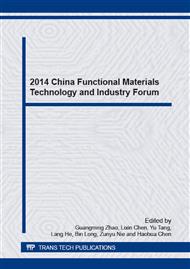p.793
p.800
p.807
p.815
p.822
p.831
p.837
p.842
p.846
Electrochemical Properties Test of Vanadium Electrolyte Containing V (III) and V (IV) Ion
Abstract:
The electrochemical behavior of vanadium solution containing V (III) and V (IV) ion each 50% was characterized by cyclic voltammetry and chronopotentiometry with different working electrodes, temperatures, H2SO4 concentrations and vanadium ion concentrations. Cyclic voltammetry analysis indicated that V(IV)/V(V) redox reaction at graphite electrode showed good electrochemical activity and reversibility while V(III)/V(II) redox reaction showed bad electrochemical activity and reversibility on Pt, glassy-carbon and graphite electrode. The cathodic peak current density of V(III)/V(II) couples increased first then remained almost unchanged as temperature raised and approached a maximum at 60°C. With H2SO4 concentration elevated, the electrolyte became viscous and diffusion step was the controlling step. The electrochemical activity of electrolyte increased with ascending vanadium concentration, so did the reversibility of V(IV)/V(V) couples. However, no matter what vanadium concentration was, the reversibility of V(III)/V(II) couples stayed poor. Stirring in solution benefited to the anodic peak current density of V(IV)/V(V) couples whereas it did not to the cathodic peak current density of V(III)/V(II) couples. The diffusion coefficients of V(III),V(IV) were calculated as 1.17×10-5,0.919×10-5 cm2·s-1 , respectively. Chronopotentiometry test indicated that solution as anolyte showed good charging performance while solution as catholyte showed poor charging performance.
Info:
Periodical:
Pages:
822-830
Citation:
Online since:
December 2014
Authors:
Price:
Сopyright:
© 2015 Trans Tech Publications Ltd. All Rights Reserved
Share:
Citation:


